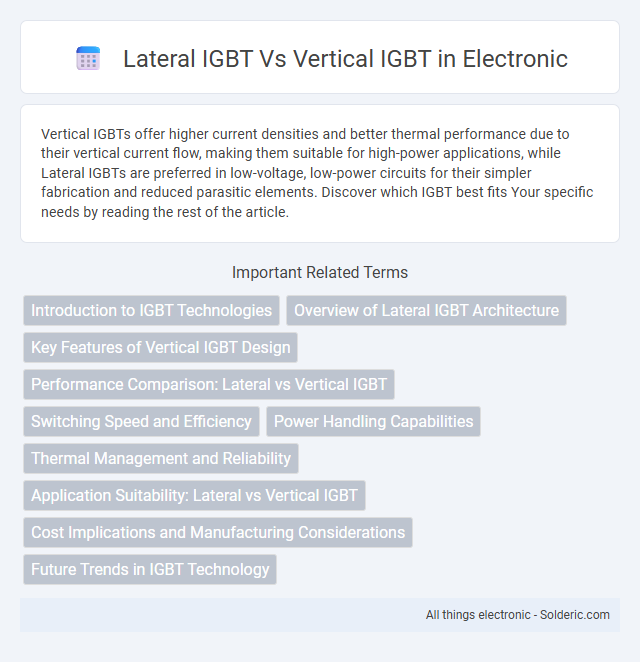Vertical IGBTs offer higher current densities and better thermal performance due to their vertical current flow, making them suitable for high-power applications, while Lateral IGBTs are preferred in low-voltage, low-power circuits for their simpler fabrication and reduced parasitic elements. Discover which IGBT best fits Your specific needs by reading the rest of the article.
Comparison Table
| Feature | Lateral IGBT | Vertical IGBT |
|---|---|---|
| Current Handling | Lower current capacity | Higher current capacity |
| Voltage Rating | Typically lower, up to 600V | Higher, up to several kV |
| Switching Speed | Slower switching frequency | Faster switching capability |
| On-State Voltage Drop | Higher voltage drop | Lower voltage drop |
| Fabrication Technology | Planar, easier integration with CMOS | Complex, vertical structure for bulk current |
| Applications | Low power, ICs, integrated circuits | High power industrial, motor drives, inverters |
| Thermal Performance | Lower heat dissipation capability | Better thermal management |
| Cost | Generally lower cost for low power | Higher cost but efficient for high power |
Introduction to IGBT Technologies
Lateral IGBT technology features current flow parallel to the device surface, enabling compact layouts suited for low-voltage applications and high switching frequencies, whereas Vertical IGBT technology directs current perpendicularly through the device, supporting higher voltage and current ratings with better thermal performance. Vertical IGBTs are preferred in power electronics for industrial applications due to their robustness and efficiency in handling large power loads. The choice between lateral and vertical IGBT designs depends on voltage, current requirements, switching speed, and thermal management considerations.
Overview of Lateral IGBT Architecture
Lateral IGBTs feature a planar structure where the current flows horizontally from the emitter to the collector, enabling easy integration with CMOS processes for compact power devices. This architecture offers advantages in low-voltage applications due to its reduced on-resistance and enhanced switching performance. Your choice of lateral IGBT can improve device efficiency and thermal management in low- to medium-power electronic circuits.
Key Features of Vertical IGBT Design
Vertical IGBT design features a vertical current flow path, enabling higher current density and superior heat dissipation compared to lateral IGBTs. The structure incorporates a bottom-layer collector and a top-layer emitter, optimizing on-resistance and switching performance for high-voltage applications. Advanced trench gate technology enhances switching speed and reduces conduction losses, making vertical IGBTs suitable for industrial power electronics and electric vehicle inverters.
Performance Comparison: Lateral vs Vertical IGBT
Vertical IGBTs typically offer superior current-carrying capacity and lower conduction losses compared to Lateral IGBTs, making them ideal for high-power applications. Lateral IGBTs feature faster switching speeds and simpler fabrication processes, which benefits low-voltage and integrated circuit designs. Your choice depends on balancing efficiency, frequency response, and power rating requirements within your specific application.
Switching Speed and Efficiency
Vertical IGBTs typically offer higher switching speeds and greater efficiency compared to lateral IGBTs due to their optimized current flow path and reduced on-resistance. The vertical structure allows for better heat dissipation and lower conduction losses, enhancing overall performance in high-power applications. You can expect improved efficiency and faster switching in devices using vertical IGBTs, making them ideal for demanding power electronics.
Power Handling Capabilities
Vertical IGBTs exhibit superior power handling capabilities compared to lateral IGBTs due to their vertical current flow design, which minimizes resistance and allows for higher current densities. This structure enables vertical IGBTs to efficiently manage high voltage and current levels, making them ideal for power-intensive applications such as motor drives and inverters. Your choice of IGBT type should consider these characteristics to optimize performance and reliability in high-power environments.
Thermal Management and Reliability
Vertical IGBTs offer superior thermal management due to their structure, enabling better heat dissipation across the silicon wafer, which enhances device reliability and longevity in high-power applications. Lateral IGBTs, while easier to integrate in low-voltage circuits, typically face higher thermal resistance, limiting their performance under heavy thermal stress. When optimizing Your design for reliability and effective heat management, Vertical IGBTs are preferred for demanding environments requiring robust thermal control.
Application Suitability: Lateral vs Vertical IGBT
Lateral IGBTs are preferred in low-voltage, high-frequency applications such as power management in portable devices due to their planar structure and ease of integration with other components. Vertical IGBTs excel in high-voltage, high-power industrial applications like motor drives and power inverters because of their superior current handling capacity and lower conduction losses. The choice between Lateral and Vertical IGBT depends on voltage ratings, switching frequency, and power density requirements of the specific application.
Cost Implications and Manufacturing Considerations
Lateral IGBTs typically offer lower manufacturing costs due to simpler wafer processing and compatibility with standard planar fabrication, making them suitable for cost-sensitive applications. Vertical IGBTs, while more expensive to produce because of complex 3D structures and thicker substrates, deliver superior current handling and efficiency for high-power devices. Your choice between these types depends on balancing initial cost constraints against performance requirements in manufacturing scalability.
Future Trends in IGBT Technology
Future trends in IGBT technology emphasize the advancement of Vertical IGBTs due to their superior current density, thermal performance, and scalability for high-power applications compared to Lateral IGBTs. Innovations such as trench gate structures and enhanced chip packaging are propelling Vertical IGBTs to achieve higher efficiency and faster switching speeds, critical for electric vehicles and renewable energy systems. Research also focuses on integrating wide-bandgap materials like SiC to further improve the reliability and performance of Vertical IGBTs in next-generation power electronics.
Lateral IGBT vs Vertical IGBT Infographic

 solderic.com
solderic.com